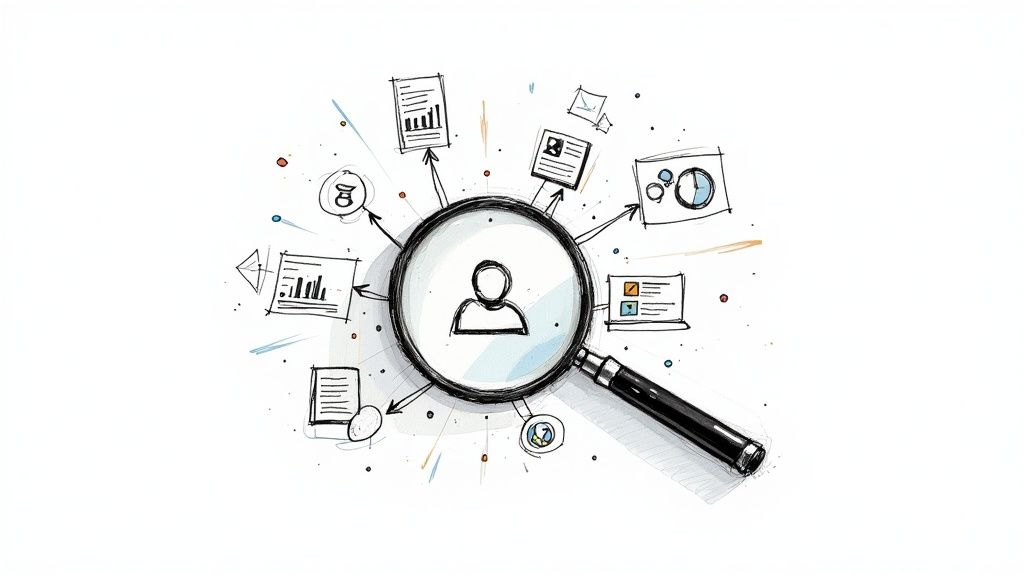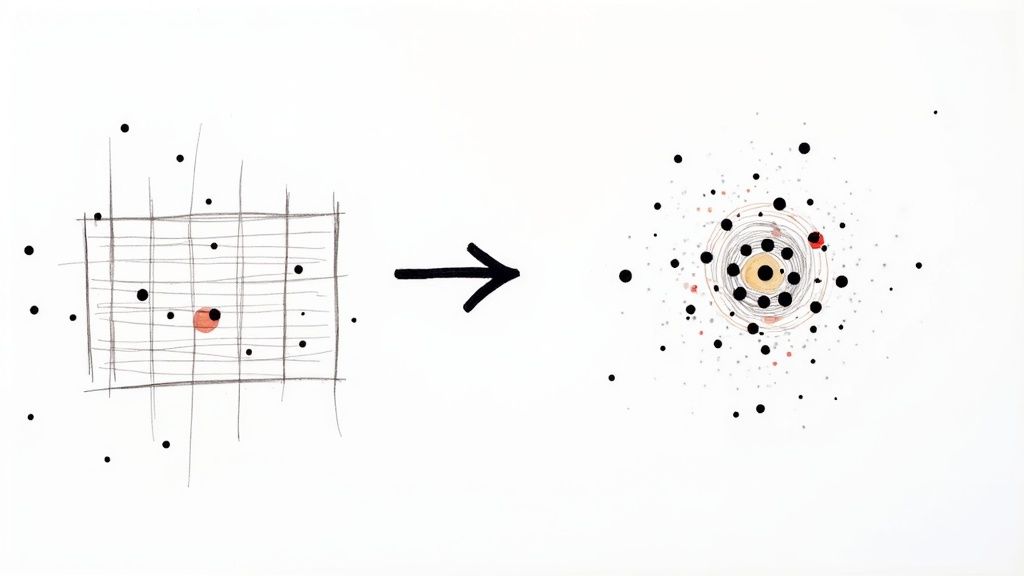
Mastering Lead Generation for Healthcare: Proven Strategies for 2025
Master lead generation for healthcare with proven strategies for 2025. Learn to attract, nurture, and convert quality leads in the complex healthcare market.

So, what exactly is a buyer persona? Think of it as creating a detailed, semi-fictional profile of your ideal customer. It's not about making things up; it's a process of digging into real data about your customers—their demographics, what drives them, and what problems keep them up at night.
This groundwork helps you make smart, informed decisions. It’s how you ensure your marketing messages actually hit home with the people you’re trying to reach.

In the real world, a well-built buyer persona is the foundation of any marketing strategy that actually works. Without one, you're just guessing—throwing messages out there and hoping something sticks.
Having a clear persona is the difference between a campaign that connects and one that falls flat. It shapes everything you do, from the blog topics you choose and the email subject lines you write to the features you build into your next product.
When you genuinely get who your ideal customer is, you can shape every interaction to fit their specific needs. This isn't just a feel-good exercise; it has a direct impact on your bottom line.
In fact, it's become a critical strategy. Over 60% of companies that updated their personas in the last six months blew past their lead and revenue goals. Why? Because they were able to connect with their audience on a much deeper, more authentic level.
Personas allow you to move from a broad, generic approach to a focused, personalized one. Instead of shouting into a void, you’re having a one-on-one conversation with your ideal customer.
This shift delivers tangible results:
If you want to dive deeper, check out this comprehensive guide on creating buyer personas.

The best buyer personas are built on a foundation of real data, not just boardroom assumptions. To paint a picture that helps your marketing, you need to blend hard numbers with human stories. It's about combining quantitative facts with qualitative feelings.
Your first stop should be the data you already own. Dive into your website analytics and CRM—these are treasure troves of information. Look for trends in demographics, user behavior, and which channels are bringing people to you. This data gives you the solid skeleton for your persona.
Who better to learn from than the people who have already bought from you? Your current customers are your single greatest source of truth. They chose you for a reason, and figuring out that "why" is everything.
You'd be surprised how many customers are willing to share their thoughts if you just ask. Here are a few ways to get the conversation started:
One of the main goals here is uncovering what bothers your customers. A huge part of this process is properly identifying customer pain points through this research.
When you mix analytics with actual conversations, you go beyond basic demographics. You start to understand the why behind what your customers do, which is the secret to creating a persona that gets results.

Okay, you’ve done the hard work of collecting information. Now you’re likely staring at a mountain of survey answers, interview transcripts, and website analytics. This is where the real work begins. Your mission is to sift through this raw data and find the golden threads that will weave together into a believable persona.
Start by looking for echoes. Do you see the same frustration in multiple customer interviews? Is a specific feature mentioned repeatedly? Perhaps your analytics show users from a certain industry spend 80% more time on your case studies page. These patterns are your first clues.
As you spot these trends, you'll naturally see groups forming. This is where you begin to segment your audience, not just by demographics, but by what truly makes them tick. Think less about who they are and more about what drives their behavior.
A few practical ways to group the data are:
This process elevates a simple profile into a powerful tool. You’re not just listing facts; you're building a story that explains why these people need you. This is the heart of any solid data-driven marketing effort.
This is a big shift from how personas used to be made. Today, we blend the art of qualitative observation with the science of hard numbers. This combination grounds our assumptions in reality and removes much of the guesswork.
To get this right, you need to pull from a variety of sources. Each one gives you a different piece of the puzzle. Here’s a quick breakdown of where to look and what you’ll find.
Each of these sources provides a unique lens. By combining the "what" from your quantitative data with the "why" from your qualitative research, you'll start to see a complete picture of your ideal customer emerge.

This is where all that hard work digging through data pays off. You’re about to turn notes and survey results into a living character that your entire team can get behind. We're not just listing facts; we're crafting a story. The goal is a simple, one-page snapshot that anyone can glance at and instantly "get."
First, make them human. Give your persona a name—alliteration helps, like “Startup Steve” or “Marketing Mary”—and find a stock photo that fits their vibe. It’s amazing how much easier it is for your team to talk about Steve as a real person instead of "the target demographic."
Now it’s time to flesh out the persona with the details you've uncovered. Think of it as creating a character sheet for your marketing campaigns, where every detail is backed by the patterns you found in your research.
Structure the profile with clear, scannable sections:
By organizing your persona this way, you create a genuinely useful tool. It’s a document that doesn't just tell you who your customer is, but explains why they make the choices they do.
To really make it stick, add a short narrative or a couple of powerful quotes directly from your interviews. Nothing makes a persona feel more real than hearing their own words. This is the secret to building buyer personas that your sales and marketing teams will actually use.
A persona profile that just sits in a shared drive is a massive wasted opportunity. The whole point is to breathe life into these profiles by weaving them into your daily grind.
When you do this, you stop guessing and start knowing. Every piece of content, every product feature, and every customer interaction can be guided by a clear understanding of who you're talking to. This is where all that research pays off with real, measurable results.
Your personas shouldn't just be a marketing thing; they should be a go-to resource for multiple teams. This keeps everyone aligned and speaking the same language about who your customers are.
Here’s how different teams can use them:
Think of your personas as a constant gut-check. Before you pour money into a new campaign, ask: "Would this actually appeal to Startup Steve?" It’s a simple filter that keeps you focused.
This isn't just a "nice-to-have." The impact is huge. Marketers who nail this are a whopping 215% more likely to report that their strategies are effective. If you want to dive deeper, you can explore detailed research on buyer persona effectiveness.
Ultimately, putting your personas into action is how you create a customer experience that feels personal and cohesive. It's also a foundational step for bigger projects, which you can organize with a solid marketing campaign planning template.
Let’s tackle some common questions to help you avoid pitfalls and keep your project moving.
One of the first things people ask is, "So, how many buyer personas do we actually need?"
Honestly, there's no single right answer. It's tempting to think more is better, but that's rarely the case. A startup might be perfectly served by one or two rock-solid personas, while a larger enterprise could need five or more.
The golden rule is quality over quantity. Start by profiling your most important customer segment. Don’t add another persona unless you can identify a truly distinct group with unique goals and pain points.
It's easy to create personas, file them away, and forget them. That's a huge mistake. Think of your personas as living documents, not one-and-done projects. Markets change, trends emerge, and your customers' needs evolve.
A persona isn't a static snapshot. It's a dynamic tool that should grow and adapt alongside your audience, keeping your marketing sharp and on point.
As a general guideline, plan to review and refresh your personas at least once a year. You should also revisit them anytime you see a major shift in the market or in your own customer data. If your sales team notices a new type of buyer consistently popping up, that's your cue to investigate.
This is the most important question. How do you prove these aren't just a creative exercise? The impact of your personas should tie directly back to your marketing goals. When you get them right, you'll see it in the numbers. Well-crafted personas should lead to things like:
Ultimately, it comes down to business results. Learning how to measure marketing ROI is the key to connecting the dots between your persona research and real revenue. It’s how you prove their value to everyone in the company.
Ready to stop guessing and start targeting the right customers with precision? At BrandBooster.ai, we use data-driven insights to build powerful marketing strategies that deliver real results. Let us help you connect with your ideal audience and grow your business. Find out how we can boost your brand at https://www.brandbooster.ai.